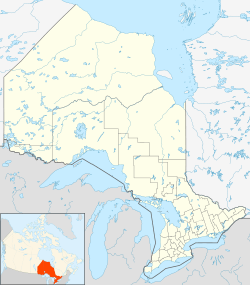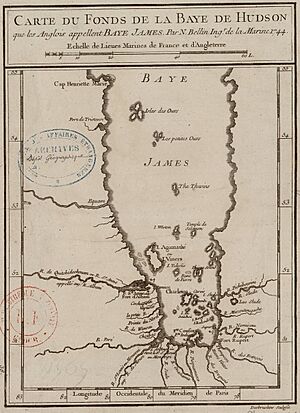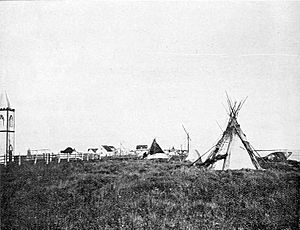Fort Albany First Nation facts for kids
Fort Albany First Nation is a Cree First Nation community in Northeastern Ontario, Canada. It is located in the Cochrane District, on the southern shore of the Albany River. This area is close to where the river meets James Bay.
The community is part of the Mushkegowuk Council and the Nishnawbe Aski Nation. It is also a signatory of Treaty 9, an important agreement with the Canadian government. Fort Albany First Nation can only be reached by air, water, or a special winter road.
The First Nation shares its members and the Fort Albany 67 Indian Reserve with the Kashechewan First Nation. Kashechewan is a separate community that formed from Fort Albany in the late 1950s. Fort Albany First Nation is built on Sinclair and Anderson Islands. It also has parts on the mainland along the river's south shore.
The community's English name comes from Fort Albany. This was one of the oldest trading posts of the Hudson's Bay Company. The current community is not exactly where the old trading post was. The post moved several times before closing around the 1950s.
Contents
History of Fort Albany
The Mushkegowuk or Swampy Cree people have lived on the western shore of James Bay for a very long time. They hunted, fished, and gathered food in the Albany River area. They shared their land with other Algonquian peoples, like the Anishinaabe. Their society was based on large families living in groups. In winter, these groups spread out. In summer, they gathered in bigger groups for fishing.
Fur Trade Era
Around 1675, Charles Bayly explored the Albany River area. He was the first overseas governor of the Hudson's Bay Company. In 1679, the company set up a trading post there. They traded goods with the Indigenous people of the area.
During the centuries of the North American fur trade, the Mushkegowuk did not sell their land. Instead, they traded furs and goods with the traders. Only a few dozen traders lived at the posts at any time. By 1856, the Hudson's Bay Company thought about 1,100 Indigenous people lived in the Albany District. This area included several trading posts.
The Canadian Pacific Railway was finished in 1885. It passed near the land that divided the James and Hudson Bay watersheds. After this, Indigenous people in the James Bay area faced new challenges. These included fewer animals for hunting and new sicknesses. European hunters and miners also started coming onto their land.
In the late 1800s, the ancestors of today's Fort Albany and Kashechewan First Nations settled at a place called Old Post. They lived there until the mid-1950s. They had to move because of severe spring floods.
Treaty No. 9
To protect their rights and animal populations, Indigenous leaders asked the Canadian government for a treaty. They wanted a treaty similar to others signed nearby. At first, Canada did not respond due to disagreements about land and money. But after another request in 1901, the treaty process began.
In 1904, minerals were found in Northwestern Ontario. This made a treaty more urgent for the government. Canada and Ontario agreed on the terms of Treaty No. 9 in July 1905. They did this without talking to Indigenous peoples first. Then, they went to the communities to get them to agree.
The Treaty Expedition arrived at Fort Albany on August 3, 1905. This was their fourth stop on the trip. They explained parts of the agreement to community leaders through interpreters. After this, the leaders signed the treaty. The community received a Union Jack flag and cash gifts. Most people received $8 and a promise of $4 each year. Charlie Stephen was the Chief who signed for Fort Albany.
The commissioners said they fully explained the treaty. They also mentioned choosing a reserve. One commissioner noted that the King wanted to set aside land for their use. No white person would be allowed on this land. After the signing, a celebration feast took place. The expedition then moved on to other communities.
Fort Albany First Nation Today
Treaty 9 said that reserve lands would be set aside. It also set up a band government under the Indian Act.
St. Anne's Indian Residential School
In 1906, the Canadian government started funding St. Anne's Indian Residential School. This school had opened in 1902 on Albany Island. It was run by religious groups. The school was part of the Canadian Indian residential school system.
Students came from First Nations all around the James Bay area. The school moved in 1932 and was rebuilt after a fire in 1939. The Canadian government took over the school's management in 1965. In 1976, the school was given to the Fort Albany band council. In 1990, former Chief Edmund Metatawabin helped start a meeting for people who had attended the school. This led to efforts to address the difficult experiences many students had there.
End of the Fur Trade Era
In the 1950s and 1960s, the fur trade began to end. The Cree people started to live in one place more often. The Old Post site was left, and the community moved to the current Fort Albany location. The government started providing homes and payments to Cree people who settled in Fort Albany. With more community organization, Indigenous people began to ask the government for new buildings, Indigenous rights, and self-government. The Grand Council of Treaty 9 was formed in 1973 to support First Nations. It later became the Nishnawbe Aski Nation.
Split with Kashechewan
In 1958, disagreements arose between different religious groups in Fort Albany. This led some families to move to the north shore of the river. This new site became known as Kashechewan First Nation. Most Anglican families from Fort Albany moved there over the next three years. By 1960, the government recognized the new community as separate. However, Fort Albany and Kashechewan still shared the same chief and council for a while. In 1977, they got separate Band Councils. Today, Fort Albany and Kashechewan are separate communities. New Fort Albany is mostly Roman Catholic, while Kashechewan is mainly Anglican.
Recent Developments
In 1994, the Minister for Indian Affairs visited Fort Albany. Students asked for a new school building. The old building had problems and needed many repairs. A new school building was finished in November 2001.
In 2007, problems like mould were found in some new houses. This made residents sick. In April 2008, Fort Albany had a big flood. Ice breaking up on the Albany River caused it. Many people had to be moved to other cities.
In 2011, Fort Albany, Kashechewan, and Attawapiskat declared a state of emergency. This was due to a housing shortage. In 2012, Fort Albany and Kashechewan held a gathering at the Old Post site. They celebrated their shared history.
Geography and Climate
Fort Albany is on the south bank of the Albany River, near James Bay. The community has three parts: one on the mainland, one on Sinclair Island, and one on Andersen Island. It shares the Fort Albany 67 reserve with Kashechewan.
Fort Albany has a subarctic climate. This means it has mild summers and very cold winters. The average yearly temperature is below freezing. Summers have an average high of 22 degrees Celsius (72 degrees Fahrenheit). The area gets about 569 millimeters (22 inches) of rain each year. More rain falls in the summer.
| Climate data for Fort Albany | |||||||||||||
|---|---|---|---|---|---|---|---|---|---|---|---|---|---|
| Month | Jan | Feb | Mar | Apr | May | Jun | Jul | Aug | Sep | Oct | Nov | Dec | Year |
| Mean daily maximum °C (°F) | −15 (5) |
−11 (12) |
−4 (25) |
2 (36) |
11 (52) |
18 (64) |
22 (72) |
20 (68) |
14 (57) |
7 (45) |
−1 (30) |
−10 (14) |
4 (40) |
| Daily mean °C (°F) | −22 (−8) |
−19 (−2) |
−12 (10) |
−3 (27) |
5 (41) |
11 (52) |
15 (59) |
14 (57) |
9 (48) |
3 (37) |
−5 (23) |
−16 (3) |
−2 (29) |
| Mean daily minimum °C (°F) | −28 (−18) |
−27 (−17) |
−19 (−2) |
−9 (16) |
−1 (30) |
5 (41) |
9 (48) |
8 (46) |
4 (39) |
−1 (30) |
−9 (16) |
−21 (−6) |
−7 (19) |
| Average precipitation mm (inches) | 26 (1.0) |
21 (0.8) |
18 (0.7) |
24 (0.9) |
34 (1.3) |
82 (3.2) |
97 (3.8) |
76 (3.0) |
74 (2.9) |
59 (2.3) |
32 (1.3) |
28 (1.1) |
571 (22.3) |
Annual Ice Break-up
Every spring, the ice on James Bay and the Albany River breaks up. This can cause big floods in the community. Dangerous ice chunks float down the river. During this time, the islands are often cut off from the mainland. People sometimes have to be moved by canoe or airlifted to safer places. In the 1990s, the First Nation built dikes to protect against high water.
In 2020, Fort Albany and Kashechewan started the "On the Land" program. This program helps community members live on the land during the break-up. It also helps promote traditional food gathering and sharing knowledge between generations.
Community and People
Population and Language
The Fort Albany community has about 1,200 people. The entire First Nation, including those shared with Kashechewan, has about 5,000 members.
Most residents speak an Indigenous language at home. The Swampy Cree language is the language of the Mushkegowuk people. Children learn both Cree and English from a young age. Many languages are spoken in the community, including English, French, Cree, Ojibway, and Oji-Cree.
Beliefs and Spirituality
The two main forms of spirituality in Fort Albany are Christianity (Roman Catholicism) and Cree spirituality.
Economy and Jobs
The local economy includes traditional activities like trapping, fishing, and hunting. There are also seasonal jobs in construction for big projects. Some people work for the Fort Albany First Nation office or local health services. Other jobs are at the hospital, the Northern Store, and with airlines like Air Creebec. There are also small private businesses.
Arts and Culture
From August 4 to 6, 2005, Fort Albany hosted Creefest. This festival celebrates Cree culture. It is organized by the Mushkegowuk Council.
In 2021, former Chief Mike Metatawabin worked with a Swiss musician. They performed a piece called "Songs of the Land." It shared his experiences and feelings about the land.
Infrastructure and Services
Transportation
Fort Albany can be reached by air, water, and the winter road. The winter road is only open from January to March. Air Creebec offers daily flights for passengers and cargo. These flights connect to cities like Toronto and Montreal through Timmins.
Fort Albany is also reached by water using James Bay and the Albany River. Barges bring supplies to the community in the summer. People also use outboard motors and canoes for hunting, trapping, and fishing. In winter, snowmobiles are the main way to get around. There are also trucks, vans, and all-terrain vehicles.
The winter road was finished in 1974. It connects Fort Albany to nearby communities like Attawapiskat, Moosonee, Moose Factory, and Kashechewan. There are plans to build a permanent all-season road. This road would connect these communities to each other and to the main provincial highway system.
Air Travel
Fort Albany Airport is used by Air Creebec for passengers and freight. A return flight to Timmins costs about $921.90 for an adult. Other small airlines also offer charter flights. Air Creebec also flies patients to hospitals in other communities.
Healthcare Services
Healthcare in Fort Albany is provided by the Fort Albany Hospital. It has 17 beds and is staffed 24/7 by nurses. Doctors from the Weeneebayko Area Health Authority provide advice. Patients needing more care are sent to hospitals in Timmins and Kingston.
In 1994, a volunteer Emergency Response Team was created. This helped reduce how long it took to respond to medical emergencies.
Food Access
In 2011, a partnership began to ship fresh food to Fort Albany and other James Bay communities. This helps ensure people have access to healthy food.
Internet Access
As of October 2022, Starlink provides fast satellite internet to Fort Albany. The Western James Bay Telecom Network also provides high-speed fibre-optic internet. This network was built in 2009.
Education
The band runs Peetabeck Education, which manages Peetabeck Academy. This school teaches students from kindergarten to grade 12. The school building was designed for 333 students. It has classrooms, a library, a gym, and rooms for different subjects. It also includes a community center. The school had its grand opening in 2001.





